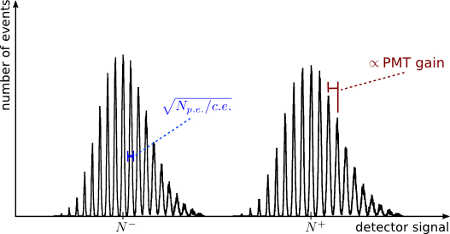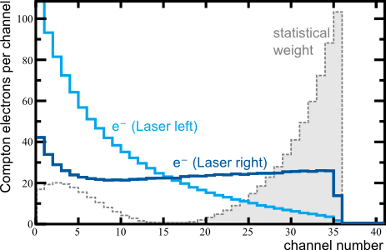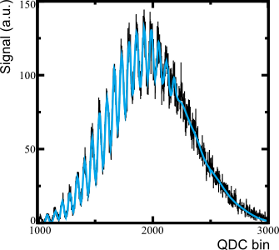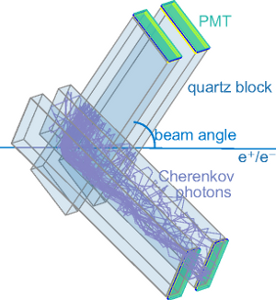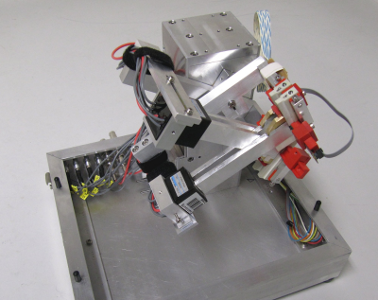Figure 1: Resolvable single peaks from simulated detector signal.
Quartz Cherenkov Detector
Quartz Cherenkov Detector R&D
Research and Technologies for Future Particle Physics Experiments
Quartz Cherenkov Detector R&D
Why consider a quartz detector?
The non-linearity of the photomultiplier tubes (PMTs) used to measure the Cherenkov light is one of the major contributions to the uncertainty of the polarization measurement. This makes the calibration of the PMT gain very important. Due to its relatively high refractive index (n ≈1.45), quartz has a much higher photon yield than gases used in designs like our gas Cherenkov detector. This fact could make it possible to resolve single peaks, thereby allowing to build a "self-calibrating" detector. Figure 1 shows how a polarisation measurement could look like in this case.
Requirements
To resolve single peaks in the measured light, two factors are important: a small number of Compton electrons per detector channel, and a high number of detected photons for each electron. The Monte Carlo simulations in figure 2 show that for 30 electrons per channel (for the channels with the highest statistical weight), ≈800 photon hits per electron are sufficient.
Optical simulation of a quartz detector
Different detector layouts were studied using the GEANT4 Monte Carlo framework. The simulated setup consists of quarts blocks with adjustable side length, wrapped in aluminum foil. Every second quartz block is flipped with respect to its neighbor, to provide more space for readout electronics. A sketch of this layout can be seen in figure 3 (left). With this simulation setup, the light yields of different quartz block configurations were investigated. This allowed to develop a detector layout in which the simulation showed the required number of photon hits per incident electron. If a segmented photodetector is used, additional information about the detector alignment can be gained by looking at the anodes seperately. Figure 3 (right) shows the photon hits for the chosen setup, a quartz block with dimensions 5x16x100mm ³ and two photodetector anodes per quartz block.
Construction and test of a prototype
Based on the simulation studies, we chose a detector geometry that consists of channels with a width of 5 mm, a height of 16 mm and a length of 100 mm. With this configuration, it should be possible to achieve single-peak resolution for up to 30 Compton electrons or positrons per channel. To test this, we designed and built a first prototype with four channels. The fully assembled prototype has been operated in a first testbeam campaign at the DESY II testbeam in April/May 2013, and the data is currently being analysed. The goal for the testbeam period is to test the detector with single electrons, compare the light yield to the expectations from the simulation, and to study the detector response for different angles and positions of the incident electron.
more details can be found in:
J. List, A. Vauth and B. Vormwald, A Quartz Cherenkov Detector for Compton-Polarimetry at Future e+e- Colliders,
JINST 10 (2015) P05014, [arXiv:1502.06955 physics.ins-det].
